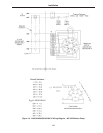
Installation
1-11
WARNING
_____________
Pumps and their components are designed for vacuum service; they
are not designed to be pressurized which could cause them to burst
possibly expelling shrapnel at lethal velocities. Serious accidents have
been caused by intentional pressurization of vacuum systems and their
components. Never pressurize any part of a vacuum system for test
or any other purpose. Always provide pressure relief when designing
diffusion pumps into systems and ensure that pressure relief motion is
limited to safe envelopes.
a Confirm the vacuum ultimate pressure characteristics of the mechanical pump. This should closely
approximate the value quoted in the manufacturer's data, if the mechanical pump is correctly
installed, adjusted, and filled with clean oil. Pressure measurements should be made with a con-
tinuously indicating total pressure gauge, such as a thermocouple gauge. This test can be per-
formed to evaluate either valved or unvalved systems. Connect the outlet or foreline of the diffusion
pump to the inlet of the mechanical backing pump, using appropriate vacuum-tight connections.
b In the case of a valved system, close the roughing valve and main isolation valve ahead of the dif-
fusion pump. In the case of unvalved systems, the entire work chamber volume must be included
in the test. Evacuate the entire system with the mechanical pump only. Let the mechanical pump
reach an ultimate pressure in the system. This reading should approximate the value obtained in
step a above (usually 10 to 50 microns (1.33 to 6.65 Pa)). If it does not, examine for leakage. If
leakage is suspected, follow standard procedures for leak testing. These will depend on the type
of vacuum gauges and/or leak detection equipment available. The most effective are Varian's heli-
um leak detectors.
1-7 ADDING PUMP FLUID
WARNING
_____________
The risk of explosion in large pumps is increased by hydrocarbon oils,
low fuel levels, or admitting atmospheric pressure during operation.
Never operate diffusion pumps larger than 6 inches with hydrocarbon
oils without a complete safety analysis for the specific system and appli-
cation. Hydrocarbon oils are more prone to explode than synthetic sili-
cone-based oils, similarly the larger the diffusion pump the greater the
risk of explosion. Running the pump with low oil level causes overheat-
ing and the oil to be decomposed and become very toxic. Such decom-
posed oil and any residue from toxic/corrosive materials pumped may
be present on the dipstick when the fluid level is measured.
NOTE
________
Fluids must be stored in clean, tightly closed containers and should be
clearly identified in accordance with their type. Do not mix pumping flu-
ids of different types and origins. Generally, it is not a good idea to mix
used and new fluid for a pump charge.


















